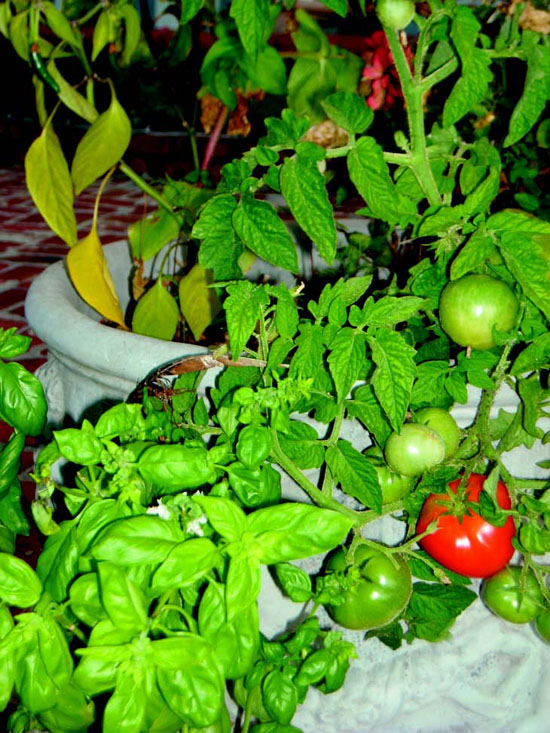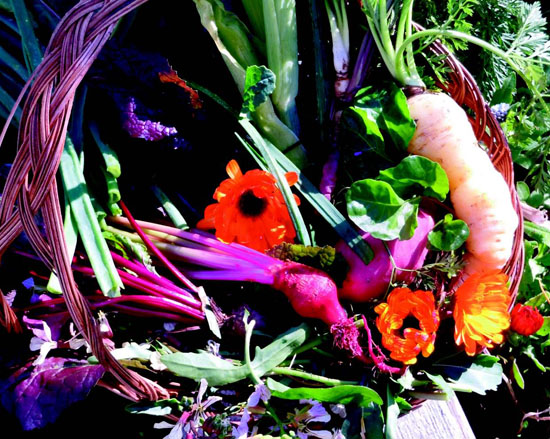 | | | Nasturtium is a supportive flower to many other flowers and vegetables. Photos Cynthia Brian | | | | | | "Be careful the environment you choose for it will shape you; be careful the friends you choose for you will become like them." - W. Clement Stone
 People have acquaintances, friends, and best friends. We may like or dislike our acquaintances, get along with our friends, and really love our best friends. In fact, when it comes to our best friends, we sometimes feel that we couldn't live without them. Most of the time, we discover that we are different than our BFFs, yet complementary. In the world of nature, plants have favorite companions as well as ones that they wish they'd never encounter. By planting our gardens in potagers that include herbs, fruits and flowers instead of in rows, we gain destructive insect-repellent properties, beneficial insect attractors with benefits of higher yields and healthier plants.
People have acquaintances, friends, and best friends. We may like or dislike our acquaintances, get along with our friends, and really love our best friends. In fact, when it comes to our best friends, we sometimes feel that we couldn't live without them. Most of the time, we discover that we are different than our BFFs, yet complementary. In the world of nature, plants have favorite companions as well as ones that they wish they'd never encounter. By planting our gardens in potagers that include herbs, fruits and flowers instead of in rows, we gain destructive insect-repellent properties, beneficial insect attractors with benefits of higher yields and healthier plants.
 As we start digging in our enriched earth this spring to plant our veggies, it is useful to know what specimens are compatible and which ones repel one another. Like humans, plants encounter other plants that they don't like, and when planted near one another, neither thrives. The idea behind companion planting is to mix flowers and herbs in a patch together. Herbs have high concentrations of aromatic oils that protect vulnerable plants from insect attacks, and many gardeners find that growing certain plants together actually increases flavor in fruits or vegetables and fragrance in blossoms.
As we start digging in our enriched earth this spring to plant our veggies, it is useful to know what specimens are compatible and which ones repel one another. Like humans, plants encounter other plants that they don't like, and when planted near one another, neither thrives. The idea behind companion planting is to mix flowers and herbs in a patch together. Herbs have high concentrations of aromatic oils that protect vulnerable plants from insect attacks, and many gardeners find that growing certain plants together actually increases flavor in fruits or vegetables and fragrance in blossoms.
 Some of the helpful herbs are rue, tansy, lavender, chamomile, Artemisia, savory, dill, rosemary, catnip, sage, thyme and pennyroyal. Supportive flowers are marigold, nasturtium and nicotiana. Garlic and chives are happy bedfellows with roses and several other plants, giving off an odor that deters aphids and blackspot. A brew of garlic tea sprayed on plants keeps pests at bay. Chamomile has often been called "the plant's physician" because it has a reputation for improving the health of surrounding flowers and herbs. Pennyroyal keeps ants away, and marigolds deter beetles, white flies, and maybe even rabbits. Nicotiana works on a trap principle where it will attract a predator, which are then caught in the sticky stems and leaves. Nasturtium is repulsive to many bugs, beetles, and moths and improves flavors while providing a cascade of edible flowers with long blooming times.
Some of the helpful herbs are rue, tansy, lavender, chamomile, Artemisia, savory, dill, rosemary, catnip, sage, thyme and pennyroyal. Supportive flowers are marigold, nasturtium and nicotiana. Garlic and chives are happy bedfellows with roses and several other plants, giving off an odor that deters aphids and blackspot. A brew of garlic tea sprayed on plants keeps pests at bay. Chamomile has often been called "the plant's physician" because it has a reputation for improving the health of surrounding flowers and herbs. Pennyroyal keeps ants away, and marigolds deter beetles, white flies, and maybe even rabbits. Nicotiana works on a trap principle where it will attract a predator, which are then caught in the sticky stems and leaves. Nasturtium is repulsive to many bugs, beetles, and moths and improves flavors while providing a cascade of edible flowers with long blooming times.
 It is fascinating that while one plant may be beneficial to many plants, it could be harmful to some. Experiment companion planting with some of these popular homegrown vegetables and see if you experience a difference in quality, quantity, flavor and pest resistance.
It is fascinating that while one plant may be beneficial to many plants, it could be harmful to some. Experiment companion planting with some of these popular homegrown vegetables and see if you experience a difference in quality, quantity, flavor and pest resistance.

 BEANS: Friends of beans include eggplant, beets, potatoes, peas, radish, chard, cucumber, everything in the cabbage family, and marigolds. Enemies of beans are garlic, onions and chives as they stunt growth.
BEANS: Friends of beans include eggplant, beets, potatoes, peas, radish, chard, cucumber, everything in the cabbage family, and marigolds. Enemies of beans are garlic, onions and chives as they stunt growth.
 KALE: Kale is currently the most hailed of the cabbage family. Its BFFs include beets, celery, spinach, lettuce and chard. Plant garlic nearby for improved growth and flavor.
KALE: Kale is currently the most hailed of the cabbage family. Its BFFs include beets, celery, spinach, lettuce and chard. Plant garlic nearby for improved growth and flavor.
 CARROTS: Tomatoes, peppers, peas, radishes and beans all are happy around carrots. Chives will increase flavor, rosemary and sage will keep the carrot flies from destroying the crop - but keep the dill in a galaxy far, far away or you'll have stunted growth.
CARROTS: Tomatoes, peppers, peas, radishes and beans all are happy around carrots. Chives will increase flavor, rosemary and sage will keep the carrot flies from destroying the crop - but keep the dill in a galaxy far, far away or you'll have stunted growth.
 CORN: Don't plant corn next to tomatoes as the same worm munches on both. Instead, corn enjoys companionship from parsley, melon, pumpkin and beans. Plant marigolds to fend off Japanese beetles.
CORN: Don't plant corn next to tomatoes as the same worm munches on both. Instead, corn enjoys companionship from parsley, melon, pumpkin and beans. Plant marigolds to fend off Japanese beetles.
 EGGPLANT: One of my most favorite vegetables to plant, it thrives with peppers and beans. Again, marigolds are friends with eggplant.
EGGPLANT: One of my most favorite vegetables to plant, it thrives with peppers and beans. Again, marigolds are friends with eggplant.
 LETTUCE: So easy to grow in a home garden, throw some seeds near strawberries, radishes and beets. Boost flavor and aphid control with garlic and chives.
LETTUCE: So easy to grow in a home garden, throw some seeds near strawberries, radishes and beets. Boost flavor and aphid control with garlic and chives.
 POTATOES: Allies are eggplant, corn, cabbages and beans. Keep tomatoes and potatoes away from one another or you'll attract blight. For protection from beetles, plant marigolds.
POTATOES: Allies are eggplant, corn, cabbages and beans. Keep tomatoes and potatoes away from one another or you'll attract blight. For protection from beetles, plant marigolds.
 PUMPKINS: Every kid wants to grow his or her own Halloween Jack O'Lantern. Squash and melons are good buddies with pumpkins. Nasturtium and oregano provide the pest protection.
PUMPKINS: Every kid wants to grow his or her own Halloween Jack O'Lantern. Squash and melons are good buddies with pumpkins. Nasturtium and oregano provide the pest protection.
 STRAWBERRIES: Thyme serves as border patrol. Lettuce, bean, onion and spinach all like to party with strawberries, but don't invite cabbage.
STRAWBERRIES: Thyme serves as border patrol. Lettuce, bean, onion and spinach all like to party with strawberries, but don't invite cabbage.
 TOMATOES: We already know that potatoes and corn are not to be planted with tomatoes, but you need to know that dill and kohlrabi will stunt growth. Friends include basil, chives, mint, celery, cucumber, onion, parsley and pepper - all the delicious ingredients of a summer salad!
TOMATOES: We already know that potatoes and corn are not to be planted with tomatoes, but you need to know that dill and kohlrabi will stunt growth. Friends include basil, chives, mint, celery, cucumber, onion, parsley and pepper - all the delicious ingredients of a summer salad!
 Cynthia Brian's Mid-Month Reminders
Cynthia Brian's Mid-Month Reminders

 CLEAR debris from your home and garden perimeter. Dried limbs, leaves, and weeds need to be removed. Fire season is upon us.
CLEAR debris from your home and garden perimeter. Dried limbs, leaves, and weeds need to be removed. Fire season is upon us.
 WATER deeply once or twice a week rather in short spurts. You'll encourage stronger roots and save on your water bill, too.
WATER deeply once or twice a week rather in short spurts. You'll encourage stronger roots and save on your water bill, too.
 DOWNLOAD a new free App: "GrowIt!" The app combines user-uploaded photos and GPS utilization with the ability to rate plants to help people find specific plants and inspiration for your locale available at both the Apple App and Google Play stores.
DOWNLOAD a new free App: "GrowIt!" The app combines user-uploaded photos and GPS utilization with the ability to rate plants to help people find specific plants and inspiration for your locale available at both the Apple App and Google Play stores.
 CUT twining stems of clematis for arrangements that will be colorful and full for three weeks, or longer.
CUT twining stems of clematis for arrangements that will be colorful and full for three weeks, or longer.
 (c)2015
(c)2015
 Cynthia Brian
Cynthia Brian
 The Goddess Gardener
The Goddess Gardener
 Starstyle(r) Productions, llc
Starstyle(r) Productions, llc
 Cynthia@GoddessGardener.com
Cynthia@GoddessGardener.com
 www.GoddessGardener.com
www.GoddessGardener.com
 925-377-STAR
925-377-STAR
 I am available as a speaker, designer, and consultant.
I am available as a speaker, designer, and consultant.

|




